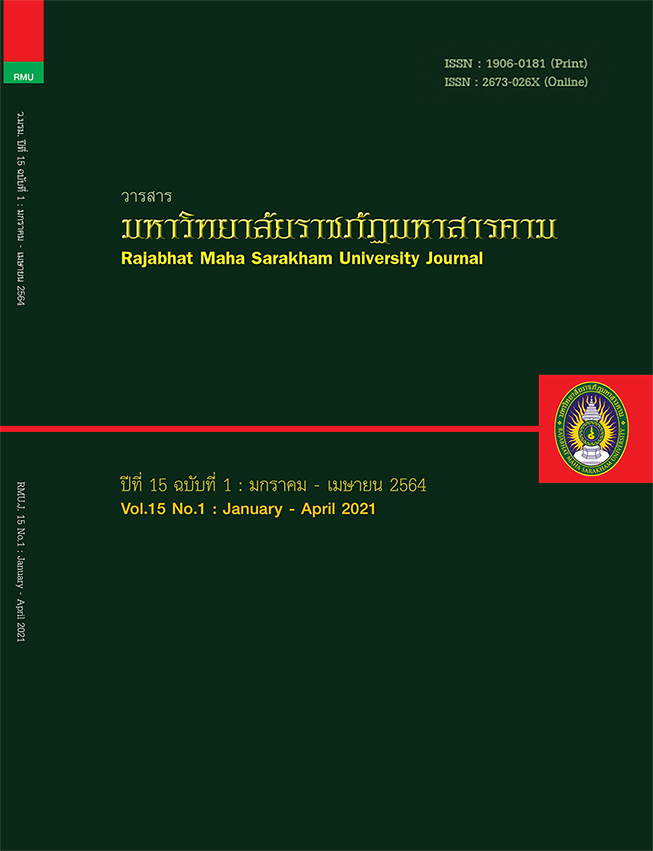การวิเคราะห์องค์ประกอบเชิงยืนยันของความเหนื่อยหน่ายในการเรียนของนักศึกษามหาวิทยาลัยราชภัฏภาคตะวันออกเฉียงเหนือ
Main Article Content
บทคัดย่อ
การวิจัยครั้งนี้มีวัตถุประสงค์เพื่อตรวจสอบความสอดคล้องของโมเดลองค์ประกอบของความเหนื่อยหน่ายในการเรียนของนักศึกษามหาวิทยาลัยราชภัฏภาคตะวันออกเฉียงเหนือกับข้อมูลเชิงประจักษ์ตัวอย่างในการวิจัย คือ นักศึกษามหาวิทยาลัยราชภัฏภาคตะวันออกเฉียงเหนือ ปีการศึกษา 2563 จำนวน 800 คน ได้มาโดยวิธีการสุ่มหลายขั้นตอน เครื่องมือที่ใช้ในการวิจัยคือ แบบสอบถามชนิดมาตราส่วนประมาณค่าโดยมีข้อคำถามแบ่งออกเป็น 8 ด้านตามองค์ประกอบรวมทั้งสิ้นจำนวน 36 ข้อมีค่าความสอดคล้องระหว่าง 0.80-1.00 มีค่าอำนาจจำแนกระหว่าง .29 ถึง .63 และค่าความเชื่อมั่นทั้งฉบับเท่ากับ .88ซึ่งใช้โปรแกรมสำเร็จรูปในการวิเคราะห์องค์ประกอบเชิงยืนยัน
ผลการวิจัยพบว่าโมเดลองค์ประกอบความเหนื่อยหน่ายในการเรียนของนักศึกษามหาวิทยาลัยราชภัฏภาคตะวันออกเฉียงเหนือ ที่ผู้วิจัยพัฒนาขึ้นมีความสอดคล้องกับข้อมูลเชิงประจักษ์ โดยมีค่าสถิติวัดความกลมกลืนของโมเดล X2=603.18, p-value=0.68, df=449, X2/df=1.34, RMSEA=0.02, GFI=0.95, AGFI=0.92 และเมื่อพิจารณาค่าน้ำหนักขององค์ประกอบ พบว่า องค์ประกอบด้านกิจกรรมการเรียนรู้มีค่าน้ำหนักมากที่สุดเท่ากับ 0.96 อย่างมีนัยสำคัญทางสถิติที่ระดับ .01ประกอบด้วย 8 องค์ประกอบ ได้แก่ 1) ด้านความภูมิใจองค์กร มีค่าน้ำหนักเท่ากับ 0.742) ด้านภาระงานที่ได้รับมอบหมาย มีค่าน้ำหนักเท่ากับ 0.85 3) ด้านปฏิสัมพันธ์ทางสังคม มีค่าน้ำหนักเท่ากับ 0.914) ด้านหลักสูตรมีค่าน้ำหนักเท่ากับ 0.905) ด้านกิจกรรมการเรียนรู้มีค่าน้ำหนักเท่ากับ 0.96 6) ด้านแรงจูงใจภายในตนเอง มีค่าน้ำหนักเท่ากับ 0.95 7) ด้านความท้าทายในการเรียนรู้ มีค่าน้ำหนักเท่ากับ 0.88 และ8) ด้านความกังวล กลัวผิดพลาด มีค่าน้ำหนักเท่ากับ 0.92
Article Details

อนุญาตภายใต้เงื่อนไข Creative Commons Attribution-NonCommercial-NoDerivatives 4.0 International License.
1. บทความที่ลงตีพิมพ์ทุกเรื่องได้รับการตรวจทางวิชาการโดยผู้ประเมินอิสระ ผู้ทรงคุณวุฒิ (Peer Review) สาขาที่เกี่ยวข้อง อย่างน้อย 3 ท่าน ในรูปแบบ Double blind review
2. ข้อคิดเห็นใด ๆ ของบทความที่ลงตีพิมพ์ในวารสารมหาวิทยาลัยราชภัฏมหาสารคาม นี้เป็นของผู้เขียน คณะผู้จัดทำวารสารไม่จำเป็นต้องเห็นด้วย
3. กองบรรณาธิการวารสารมหาวิทยาลัยราชภัฏมหาสารคาม ไม่สงวนสิทธิ์การคัดลอกแต่ให้อ้างอิงแสดงที่มา
เอกสารอ้างอิง
ทิศนาแขมมณี. (2554). ศาสตร์การสอน. กรุงเทพฯ: สำนักพิมพ์แห่งจุฬาลงกรณ์มหาวิทยาลัย.
ปิรันธ์ชิณโชติ และธีระวัฒน์ จันทึก. (2558). ข้อเสนอเชิงนโยบาย เพื่อพัฒนาการจัดการเรียนการสอน โดยการจัดการความรู้ ในการลดระดับความเบื่อหน่ายในการเรียนของนักศึกษา. วารสารสาขามนุษยศาสตร์ สังคมศาสตร์ และศิลปะ,8(2).1906-3431,พฤษภาคม-สิงหาคม.
ไพรัตน์ พงศ์พานิชย์. (2562). ระเบียบเศรษฐกิจโลกใหม่ ปัญหาท้าทายของทั้งโลก. ประชาชาติธุรกิจ ออนไลน์.สืบค้นจากhttps://www.prachachat.net/world-news/news-395716.
ยุทธ์ไกยวรรณ์. (2557). การวิเคราะห์สถิติหลายตัวแปรสำหรับงานวิจัย(พิมพ์ครั้งที่ 2). กรุงเทพฯ:สำนักพิมพ์แห่งจุฬาลงกรณ์มหาวิทยาลัย.
สำนักงานคณะกรรมการการอุดมศึกษา. (2563). คลังข้อมูลอุดมศึกษา.(ออนไลน์). สืบค้นจากhttp://www.data3.mua.go.th/dataS/.
อรพินทร์ ชูชม. (2555). แรงจูงใจใน การทำงาน: ทฤษฎี และการประยุกต์. วารสารจิตวิทยา.มหาวิทยาลัยเกษมบัณฑิต,2(2). มกราคม-ธันวาคม.
อัจศรา ประเสริฐสิน. (2555). การศึกษาตัวบ่งชี้ และพัฒนาโมเดลการวัดคุณลักษณะอันพึงประสงค์8 ประการของนักเรียนระดับชั้นมัธยมศึกษา. วารสารศิลปกรศึกษาศาสตร์วิจัย,8(1). 63-76, มกราคม-มิถุนายน.
Abaid Ur Rehman, Tariq MehmoodBhuttah, Xuqun You.(2020). Linking Burnout to Psychological Well-being:The Mediating Role of Social Support and Learning Motivation Psychology Research and Behavior Management.2020:13. pp. 545-554. published in the following Dove Press journal: Psychology Research and Behavior Management.
Bonwell, C.C. (1991). Active Learning: Creating Excitement in the Classroom AEHE-ERIC HigherEducation Report. No.1. Washington, D.C.: Jossey-Bass.
Cordes, C.L., and Dougherty, T.W. (1993). A review and anintregration of research on job burnout.The Academy of Management Review. Vol.18 No.4, 621-656.
Disley, P., Hatton, C., &Dagnan, D. (2009). Applying equity theory to staff workingwith individuals with intellectual disabilities. Journal of Intellectual &Development Disability, 34(1), 55-66.
Freedenberger, H.J., and Richelson, G. (1980). Burnout: the high cost of high achievement. Gaden City, NY: Doubleday.
Gagne, M., &Deci, E. (2005). Self-determination theory and work motivation.Journal of Organizational Behavior. 26, 331-362.
Kuittinen, M. Merilainen, M. (2011). The effect of study-related burnout on student perceptions.Journal of International Education in Business, 4(2), 42-62.
Maslach, C. and Leiter, M.P. (1997). The Truth about Burnout: How Organization Cause Personal Stress and What to Do about It, John Wiley & Sons, San Francisco, CA.
Schaufeli, W.B. Martinez, I.M. Pinto, A.M. Salanova, M. Baker, A.B. (2002). Burnout and engagement in university students A Cross-National study.Journal of Cross-Culture Psychology, 33(5), 464-481.
Stoeber, J., & Childs, J. H. (2010). The assessment of self-oriented and socially prescribedperfectionism:Subscales make a difference. Journal of Personality Assessment,92(6), 577-585.


